
There’s an episode of Yes, Prime Minister where a state funeral provides an opportunity for negotiations with the French over the Channel. As ever, this particular satire has aged well. Most of the coverage of Pope Francis’ requiem mass has focused on either the ‘spectacle’ or the chance for world leaders to connect. It's tempting to think that the main stage of St Peter's Basilica was actually a sideshow to the fringe events of politicians carving up the world. With all the planning and confections that go into usual geopolitical summits, Vatican City has provided a spectacular impromptu backdrop.
As an Anglican priest, I have mixed feelings about this. All the photos world leaders have been pushing out seem not a million miles away from the shocking taste of selfies in front of an open casket (any casket, for that matter). On the other hand, when there’s matters of life and death to discuss, there’s no better venue than a funeral.
Of course, this presupposes that leaders have the presence of mind to acknowledge the dead body before them (not 'passed away'), rather than simply going through the motions and thinking about the photo op. But the cogs of death cannot be avoided.
Tim Hamer, writing for the Lowy Institute, says, ‘bitter rivals can acknowledge the rituals of mortality.’ Some of the figures about leaders attending recent funerals are staggering. Pope Francis' funeral was no different. Along with those Francis prioritised - those pushed to the margins - there was also a critical 'mass' of those at the very centre of society. There were 170 delegations, including 50 heads of state, 15 heads of government and 12 reigning monarchs. Emeritus Professor of International Relations at the University of Leicester, Geoff R. Berridge writes that:
“Because death is always with us … there is little doubt that the working funeral is now the most important ceremonial occasion in the world diplomatic system”.
Therefore, the off chance of bilateral diplomacy must be taken to its full advantage.
It is precisely because, while the bodies are lowered, funerals elevate us out of the everyday, the 24 hour news cycle and the doomscrolling, that they provide us with an opportunity to connect with what really matters. Less than 24 hours before he died, the pope delivered the words on Easter Sunday: 'Christ is risen! These words capture the whole meaning of our existence, for we were not made for death but for life… God created us for life and wants the human family to rise again!' As our multilateral world order falters, the human family just might be able to rise again when the powers-that-be meet at a funeral.
We will have to wait and see if there is any fruit from the geopolitical meetings that have taken place. We can live in hope. If world leaders learnt any lessons from the enigmatic late pontiff, they would see that he was like Teflon to the political labels people tried to pin on him. You get the impression that he was aiming for something more lasting than soundbites, quick wins and popularity.
I would also add that funerals are for the living. Once we've brushed aside any theological quibbles over the efficacy of praying for the dead, funerals are there to help us to grieve. They help us to process loss, which is why the 'mortal remains' remain. The ancient declarations, the homily, the breaking of bread and pouring of wine, yes even the theatrics help us to situate our own lives on a world stage where we are both bit parts as well as worthy of the undivided attention of many onlookers.
In a world where geopolitics threatens to depersonalise and dehumanise countless millions of people, funerals unavoidably collide the universal with the individual. The context of worship and thanksgiving also lifts us out of the orbital pull of the ephemera of nation-states and our own lives to discover the possibility of revolving around Someone far grander and steadfast. Just like conducting diplomacy, there's no better place to consider death than a funeral.
Celebrate our 2nd birthday!
Since Spring 2023, our readers have enjoyed over 1,000 articles. All for free.
This is made possible through the generosity of our amazing community of supporters.
If you enjoy Seen & Unseen, would you consider making a gift towards our work?
Do so by joining Behind The Seen. Alongside other benefits, you’ll receive an extra fortnightly email from me sharing my reading and reflections on the ideas that are shaping our times.
Graham Tomlin
Editor-in-Chief




